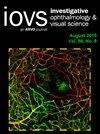In Vivo Visualization of Intravascular Patrolling Immune Cells in the Primate Eye.
IF 5
2区 医学
Q1 OPHTHALMOLOGY
引用次数: 0
Abstract
Purpose Insight into the immune status of the living eye is essential as we seek to understand ocular disease and develop new treatments. The nonhuman primate (NHP) is the gold standard preclinical model for therapeutic development in ophthalmology, owing to the similar visual system and immune landscape in the NHP relative to the human. Here, we demonstrate the utility of phase-contrast adaptive optics scanning light ophthalmoscope (AOSLO) to visualize immune cell dynamics on the cellular scale, label-free in the NHP. Methods Phase-contrast AOSLO was used to image preselected areas of retinal vasculature in five NHP eyes. Images were registered to correct for eye motion, temporally averaged, and analyzed for immune cell activity. Cell counts, dimensions, velocities, and frequency per vessel were determined manually and compared between retinal arterioles and venules. Based on cell appearance and circularity index, cells were divided into three morphologies: ovoid, semicircular, and flattened. Results Immune cells were observed migrating along vascular endothelium with and against blood flow. Cell velocity did not significantly differ between morphology or vessel type and was independent of blow flood. Venules had a significantly higher cell frequency than arterioles. A higher proportion of cells resembled "flattened" morphology in arterioles. Based on cell speeds, morphologies, and behaviors, we identified these cells as nonclassical patrolling monocytes (NCPMs). Conclusions Phase-contrast AOSLO has the potential to reveal the once hidden behaviors of single immune cells in retinal circulation and can do so without the requirement of added contrast agents that may disrupt immune cell behavior.灵长类动物眼球血管内巡逻免疫细胞的体内可视化。
目的了解活体眼球的免疫状态对于我们了解眼部疾病和开发新的治疗方法至关重要。由于非人灵长类动物(NHP)的视觉系统和免疫状况与人类相似,因此非人灵长类动物是眼科治疗开发的金标准临床前模型。在这里,我们展示了相位对比自适应光学扫描光眼底镜(AOSLO)在细胞尺度上观察免疫细胞动态的实用性,而且在 NHP 中是无标记的。方法使用相位对比 AOSLO 对五只 NHP 眼睛中视网膜血管的预选区域进行成像。对图像进行注册以校正眼球运动、时间平均和免疫细胞活动分析。人工确定每条血管的细胞数量、尺寸、速度和频率,并在视网膜动脉和静脉之间进行比较。根据细胞外观和圆度指数,将细胞分为三种形态:卵圆形、半圆形和扁平形。细胞迁移速度在不同形态或血管类型之间没有明显差异,且与血流无关。静脉的细胞频率明显高于动脉。动脉血管中类似 "扁平 "形态的细胞比例较高。根据细胞的速度、形态和行为,我们确定这些细胞为非典型巡逻单核细胞(NCPMs)。结论相位对比 AOSLO 有可能揭示视网膜循环中单个免疫细胞曾经隐藏的行为,而且不需要添加可能破坏免疫细胞行为的对比剂。
本文章由计算机程序翻译,如有差异,请以英文原文为准。
求助全文
约1分钟内获得全文
求助全文
来源期刊
CiteScore
6.90
自引率
4.50%
发文量
339
审稿时长
1 months
期刊介绍:
Investigative Ophthalmology & Visual Science (IOVS), published as ready online, is a peer-reviewed academic journal of the Association for Research in Vision and Ophthalmology (ARVO). IOVS features original research, mostly pertaining to clinical and laboratory ophthalmology and vision research in general.

 求助内容:
求助内容: 应助结果提醒方式:
应助结果提醒方式:


